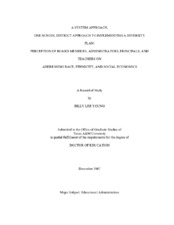| dc.description.abstract | The intent of this study was to investigate a system approach to implementing a
diversity plan in a chosen school district, with emphasis on (1) why a chosen school
district utilized a systems approach in implementing a diversity plan to meet the needs of
their ever changing ethnically diverse, disadvantaged, and multilingual population, (2)
what process did the district use in meeting the needs of a diverse population, and (3)
can a business model be transformed and used in an educational system to meet the
needs of the internal forces as well as those external forces.
The Cox’s Model for Cultural Change was used to analyze the district diversity
plan. The district diversity plan had six categories while the Cox Model has five.
According to the Cox Model, to have an effective organizational change the change
effort should include all the five themes and sub- themes. The change effort should be
continually assessed and refined over time in a process of continuous loop learning. A qualitative case study methodology was used to collect and report the data for
this study. The data collected in this study included intensive open-ended and follow-up
interviews. The data sources were comprised of one board member, three administrators,
four principals, and eight teachers. Of the sixteen participants, six members were of
color and ten were European-American teachers, principals, and administrators. The
constant comparative method was used to analyze the data.
In analysis, the themes utilized for this study, comparing the leadership of the
board member, administrators, principals, and teachers, congruence in leadership as
described by Cox did not exist. Failure to utilize all the elements of the Cox Model made
Mayflower ISD Diversity Plan weak. Lack of communication across the district
hampered Mayflower ISD to embrace diversity. The finding from this study using the
three categories Leadership, Education, and Follow-Up revealed that it was lacking in
continuity, understanding, implementation, guidance, and trust. In conjunction with the
review of literature and an analysis of the data, the findings from this study reveal that
the district will not meet its’ overall objective of embracing diversity district wide. | en |
| dc.title | A system approach, one school district approach to implementing a diversity plan: perception of board members, administrators, principals, and teachers, addressing race, ethnicity, and social economics | en |


